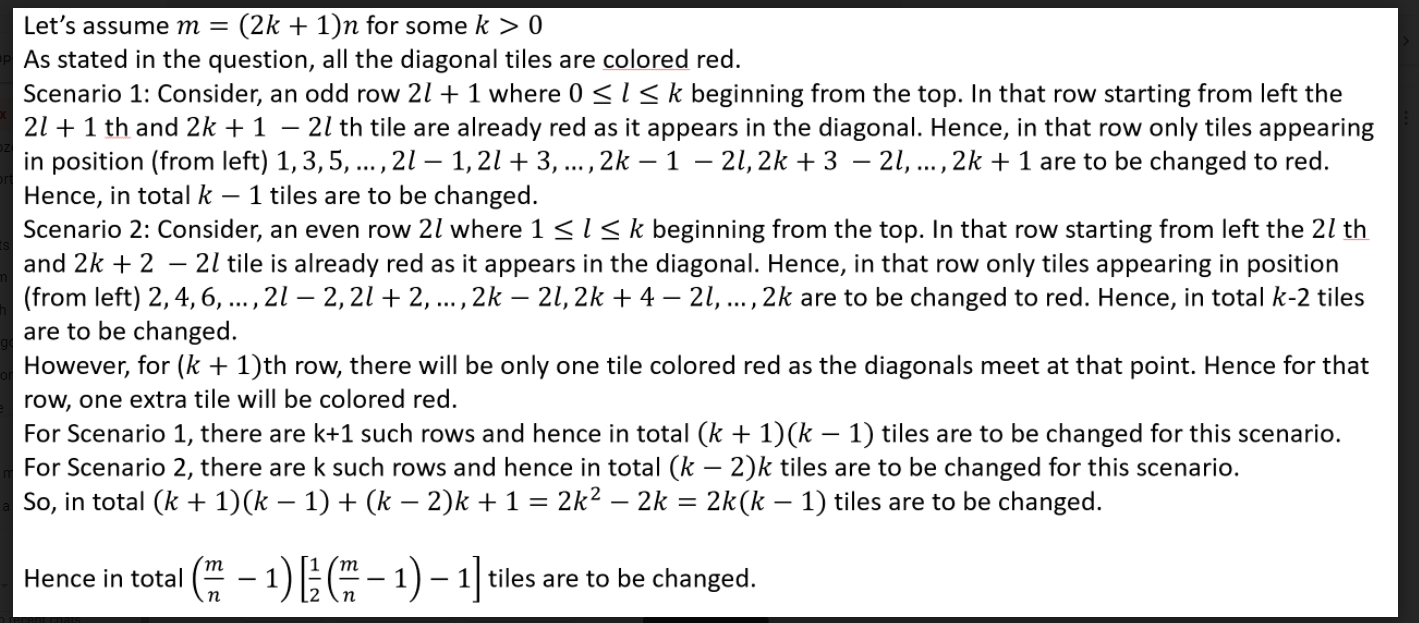A tiled floor of a room has dimensions in meters of m x m.
The dimensions in meters of the tiles used are n x n.
All tiles used are green tiles except diagonal tiles which are red.
After some years some green tiles are replaced by red tiles to form an alternate red and green tile pattern.
How many green tiles are removed?
(m is divisible by n, m is not equal to n, and the total number of tiles is odd).
Solution to the Problem:
The number of tiles that must be removed is given by the formula:

First examine several rooms and notice that the tiles to be removed form a triangular pattern. The squares with red dots are the green tiles which must be removed and replaced with red tiles. These numbers are called triangular numbers: 1, 3, 6, 10, 15, 21, ...
The formula for the nth triangular number is given below:

I noticed that the actual numbers for m and n are not as important as the ratio of m:n. For example, a 5 m by 5 m room with 1 m by 1 m tiles is the same problem as a 15 m by 15 m room with 3 m by 3 m tiles. In each room, you would need to replace 4 tiles.

I organized this information into a table, I matched the values of m/n to the triangular numbers and developed the formulas for the number of tiles needed on each side of the room (I used the formula above for the triangular numbers). Then I multiplied by four to get the total number of green tiles that need to be removed.
Brijesh Dave sent in a simpler solution:
Total number of diagonal red tiles is R = 2(m/n)-1
Total number of red tiles is [(m/n)^2 + 1 ] / 2 after replacement of green tiles.
Total green tiles to be replaced is [(m/n)^2 + 1 ] / 2 - 2(m/n)+1 = [(m-2n)^2 - n^2] / 2n^2 which is same as the solution above of 1/2 (m/n-3)(m/n-1).
Colin Bowey sent in the same formula along with a spreadsheet so he gets extra credit for his spreadsheet
Click here to download the spreadsheet for any number of tiles up to m = 99.
Ritwik Chaudhuri also gets extra credit for his excellent solution:


First examine several rooms and notice that the tiles to be removed form a triangular pattern. The squares with red dots are the green tiles which must be removed and replaced with red tiles. These numbers are called triangular numbers: 1, 3, 6, 10, 15, 21, ...
The formula for the nth triangular number is given below:

I noticed that the actual numbers for m and n are not as important as the ratio of m:n. For example, a 5 m by 5 m room with 1 m by 1 m tiles is the same problem as a 15 m by 15 m room with 3 m by 3 m tiles. In each room, you would need to replace 4 tiles.

I organized this information into a table, I matched the values of m/n to the triangular numbers and developed the formulas for the number of tiles needed on each side of the room (I used the formula above for the triangular numbers). Then I multiplied by four to get the total number of green tiles that need to be removed.
| m / n | nth triangular # | Tiles on a side | Total tiles |

|

|

|

|
| 3 | 0 | 0 | 0 |
| 5 | 1 | 1 | 4 |
| 7 | 2 | 3 | 12 |
| 9 | 3 | 6 | 24 |
| 11 | 4 | 10 | 40 |
| 13 | 5 | 15 | 60 |
| 15 | 6 | 21 | 84 |
| 17 | 7 | 28 | 112 |
Brijesh Dave sent in a simpler solution:
Total number of diagonal red tiles is R = 2(m/n)-1
Total number of red tiles is [(m/n)^2 + 1 ] / 2 after replacement of green tiles.
Total green tiles to be replaced is [(m/n)^2 + 1 ] / 2 - 2(m/n)+1 = [(m-2n)^2 - n^2] / 2n^2 which is same as the solution above of 1/2 (m/n-3)(m/n-1).
Colin Bowey sent in the same formula along with a spreadsheet so he gets extra credit for his spreadsheet
Click here to download the spreadsheet for any number of tiles up to m = 99.
Ritwik Chaudhuri also gets extra credit for his excellent solution:

Correctly solved by:
| 1. Brijesh Dave | Mumbai City, Maharashtra, India |
| 2. Colin (Yowie) Bowey | Beechworth, Victoria, Australia |
| 3. Ritwik Chaudhuri | Santiniketan, West Bengal, India |
| 4. Mohamed Sheriff | Freetown, Western area, Sierra Leone, West Africa |
| 5. Kelly Stubblefield | Mobile, Alabama |
| 6. Dr. Hari Kishan |
D.N. College, Meerut, Uttar Pradesh, India |
| 7. Veena Mg | Bangalore, Karnataka, India |